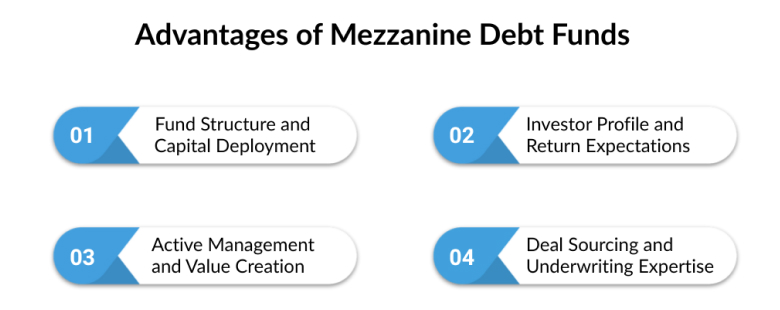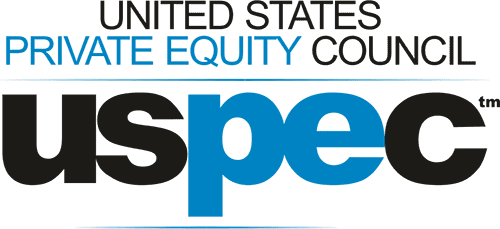Introduction
Mezzanine financing is a key component of private equity, providing a valuable blend of debt and equity that enables businesses to grow, make acquisitions, and undergo restructuring. It offers sponsors a powerful option while balancing the need for an optimal capital structure without diluting ownership, which can often accompany it. In today’s evolving private credit market, mezzanine debt is a crucial term to understand for structuring complex transactions and achieving competitive, risk-adjusted returns.
The Structure of Mezzanine Debt: Hybrid Power in Capital Stacks
Mezzanine debt is unique in a way, that it provides borrowers with fixed-income security alongside equity-linked opportunities; thereby playing a key role in advanced financial structures. Between senior debt and common equity, this hybrid tool enables private equity-backed companies to secure additional funding without having to relinquish a portion of their business immediately.
Significant components of mezzanine debt are:
-
Subordinated Debt with Fixed Returns: Mezzanine instruments are often unsecured and rank second in priority after senior loans, which are settled first. Most of the time, they charge interest rates of 10% to 14% per year, as they are riskier and less critical in the event of liquidation.
-
Equity Participation Features: Many mezzanine agreements provide lenders with the option to acquire equity if future conditions permit it. Consequently, returns are better, and mezzanine lenders support the company’s long-term success.
-
Flexible Repayment Terms: Financial covenants may include features such as payment-in-kind interest, balloon payments, and long maturities, which can support companies that are growing, even if they currently lack sufficient cash on hand.
Role of Mezzanine Financing in Private Equity Transactions
A significant part of the private equity deal process involves mezzanine debt, which adds security and helps produce better returns for investors. Since it falls between senior debt and equity, it offers flexibility for achieving various goals and does not affect ownership too soon. It is mainly applied in buyouts, the raising of growth capital, and restructuring deals where larger, cost-effective loans are not available.
-
Enhancing Transaction Flexibility: It enables private equity sponsors to tailor the capital structure of a business to their growth and financing needs, based on steady cash flow. The flexibility of payment terms is most helpful in situations where purchases are complicated or need to be made quickly.
-
Preserving Ownership Stakes: Mezzanine financing is an effective way for sponsors to maintain a minimal ownership stake for founders or current shareholders by requiring less equity for the investment than they would typically need to provide.
-
Optimizing Leverage Ratios: The use of mezzanine instruments enables leverage to be increased without breaching the borrowing agreement of senior debt for buyers, thereby allowing for higher possible returns.
-
Supporting Non-Dilutive Growth Initiatives: Companies at a growth stage utilize mezzanine financing to fund their expansion, acquire other businesses, or develop new products while maintaining control and avoiding immediate equity involvement.
Inside Mezzanine Debt Funds: Capital Providers with a Strategic Edge
Mezzanine debt funds are crucial for private equity because they provide specially tailored capital that helps bridge the gap between senior debt and equity. Such funds gather investments from pension funds and insurance companies to pursue higher rewards relative to the risk they are willing to assume by buying subordinated debt instruments that act like equity. The purpose of this is to offer businesses flexible financing to facilitate growth, purchases, or recapitalizations, while minimizing the need to relinquish additional equity holdings.

Prominent features and advantages of mezzanine debt funds include:
-
Fund Structure and Capital Deployment: Most of these fund structures are designed with set lifespans, and they carefully select their investments, conducting thorough reviews to match their investments with the associated risks.
-
Investor Profile and Return Expectations: Supported by institutional investors, these funds aim to achieve internal rates of return (IRR) of 12% to 20% through income from interest, payment-in-kind interest, and equity participation.
-
Active Management and Value Creation: Post-investment, fund managers actively support portfolio companies by advising on business strategies, enhancing operational efficiency, and planning to achieve the best outcomes from the investments.
-
Deal Sourcing and Underwriting Expertise: Leveraging strong connections and thoroughly evaluating financials, mezzanine debt funds seek out deals that meet their investment expectations.
Risk and Return Profile: Balancing Yield with Subordination
Mezzanine debt is more substantial in terms of earnings than typical debt, but is riskier than being part of the company’s equity. Nevertheless, the unique combination of risks and benefits found in hybrid securities requires everyone involved to pay close attention. Since it sits further down in the list of creditors, subordinated debt is repaid last and is thus risky, but it tends to offer higher yields.
-
Attractive Yields with Embedded Equity Upside
Earnings from mezzanine debt investments typically range from 12% to 20%, which can vary depending on the type of deal, credit rating, and economic environment. The returns can consist of interest payments, interest-like payments in kind, and the opportunity to participate in the company by holding warrants or exercising conversion features. Equity-linked gains make for a higher total return when an investment is successful.
-
Credit Risk and Subordination Exposure
Since mezzanine debt has no collateral and is not first in line to be paid in case of default, it is more likely to suffer losses. They receive higher interest rates in exchange, but it is crucial to check how stable the cash flow is, how much the assets cover, and the quality of the managers to effectively handle risks.
-
Performance Sensitivity and Capital Protection Measures
These instruments may involve contract conditions, settlement agreements between different types of lenders, and set triggers to monitor the borrower’s behavior. They help protect your money, particularly during uncertain or volatile market periods.
Industry Applications: Where Mezzanine Debt Makes the Greatest Impact
Mezzanine debt is well-suited for growing companies, particularly when they cannot utilize traditional funding and prefer to retain their equity. Since it is flexible and provides lower-risk returns, it can be used in industries where normal cash flow is the norm.
-
Healthcare Expansion and Roll-ups: Mezzanine debt is helpful for the healthcare sector when doctors merge, medical devices are expanded, and long-term care facilities are built. Sponsors use this money to acquire other businesses, retaining their shares in the process, and can thus grow their companies quickly in a controlled market that generates steady income.
-
Technology Growth Capital: Firms working on growing their software, cloud, or cybersecurity solutions in the tech sector often use mezzanine debt for funding. If a company has a lot of recurring revenue and high EBITDA multiples, using such financing helps it add resources without having to surrender control to an owner.
-
Manufacturing and Industrial Services: Businesses in the manufacturing industry often utilize mezzanine financing to increase production or expand into new markets. Having a lot of collateral and steady revenue makes it practical for these companies to repay their debts.
-
Lower-Middle-Market Companies: These companies often struggle to secure large, syndicated loans. A mezzanine loan enables financing of growth plans or the acquisition of a family business while maintaining a significant equity ownership stake.
Conclusion
Mezzanine debt is a crucial option for private equity investments, providing capital that bridges the gap between senior debt and equity capital. When the risks and returns are linked and matched, sponsors can better control leverage while managing dilution. By focusing on the middle-market companies, these funds contribute further to this space with their unique strategies. Despite changes in private capital markets, mezzanine financing is a steady and reliable tool to help companies grow sustainably and earn various kinds of investment returns.







